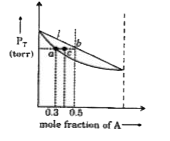An ionic compound AB has a rock salt structure with A:B=1:1. the formula mass of AB is 6.02y amu and the closest A-B distance is y1/3 nm. Calculate the density of lattice in kg m−3.Solution in Malayalam
AB has rock salt (A:B=1:1) structure i.e., fcc structure (n=4) and formula mass of AB is 6.023 y g having closest distance A−B is y1/3 nm. Therefore edge length of unit cell
a=2(A++B−)=2×y1/3×10−9m
∴Density of AB=n×molar massAv.no.×V=n×molar mass6.023×1023×a3
=4×6.02×y×10−36.02×1023×(2y1/3×10−9)3(molar mass in kg mol−1)=5.0kg m−3
Topper's Solved these Questions
- BOOK - BRILLIANT PUBLICATIONCHAPTER - SOLID STATEEXERCISE - LEVEL-3 (Statement Type)5videos
SOLID STATE
- BOOK - BRILLIANT PUBLICATIONCHAPTER - SOLID STATEEXERCISE - LEVEL-3 (Linked Comprehension Type)10videos
SOLID STATE
- BOOK - BRILLIANT PUBLICATIONCHAPTER - SOLID STATEEXERCISE - LEVEL-3 (Matching Column Type)5videos
SOLID STATE
- BOOK - BRILLIANT PUBLICATIONCHAPTER - REDOX REACTION & ELECTROCHEMISTRYEXERCISE - QUESTION (ELECTROCHEMISTRY) (LEVEL -II) (ASSERTION-REASON)3videos
REDOX REACTION & ELECTROCHEMISTRY
- BOOK - BRILLIANT PUBLICATIONCHAPTER - SOLUTIONSEXERCISE - Level-III (Linked Comprehension Type)12videos
SOLUTIONS
Similar Questions
Statement 1: In crystal lattice, the size of the tetrahedral void is larger than an octahedral void.
Statement 2: The cations occupy less space than anions in crystal packing.04:05View SolutionF centre is an example of metal excess defect due to the presence of extra cations at interstitial sites. Zinc oxide is white in colour at room temperature, on heating it loses oxygen and turns yellow.
ZnOHeat−−→Zn2++12O2+2e−
Now there is excess of zinc in the crystal and its formula becomes Zn1+x O. the excess of Zn2+ ions move to interstitial sites and the electrons to neighbouring interstitial sites.
There are many solids which are difficult to prepare in the stiochiometric composition and contain less amount of the metal as compared to stiochiometric proportion. a typical example of this type is FeO which is mostly found with a composition of Fe0.95. it may actually range from Fe0.96 O.
Q. In Fe0.95 O:02:24View SolutionMatch the crystal systems/unit cells mentioned in Column I with their characteristic features mentioned in Column II.
 View Solution
View SolutionAssertion: After the electrolysis of aqueous CuSO4 solution pH decreases.
Reason: Sulphuric acid is formed.04:55View Solution1 mole of A and 1 mole B are mixed together to form an ideal solution at 25∘C. Solution is placed in a vessel fitted with piston. If pressure on the solution is reduced isothermally.

Correct relationship between P∘AandP∘B isView SolutionA compount AB has a rock type structure with A:B=1:1 . The formula weight of AB is 6.023 Y am u and the closed A-B distance is Y^(1//3) nm. (i) Find the density of lattice. (ii) If the density of lattice is found to be 20 kg m^(-3) , then predict the type of defect.
04:05View SolutionA compound AB has a rock salt type structure with A:B=1:1 . The formula weight of AB is 6.023 y amu and the closest A-B distance is y1/3 nm. Calculate the density of lattice (in kg/m3)
04:05View SolutionA binary salt AB (formula weight = 6.023 Y amu, where Y is an arbitray number) has rock salt structure with 1 : 1 ratio of A to B. The shortes A - B distance in the unit cell is Y^(1//3)nm . (a) Calculate the density of the salt in kg m^(-3) (ii) Given that the measured denstiy of the salt is 20 kg m^(-3) , specify the type of point defect present in the crystal
02:50View SolutionAB crystallizes in a rock salt structure. The nearest distance between A and B is Y1/3 nm, where Y is a constant. The molecular mass of AB is 6.023 Y g/mol−1 .Determine the density in kgm−3.
03:01View SolutionAn ionic compound AB has a rock salt structure with A :B = 1:1. the formula mass of AB is 6.023 y amu and the closest A-B distance is y^(1//3) nm. (a) Calculate the density of the attice. (b) If the observed density of the lattice is found to be 20 " kg m"^(-3) . then predict the type of defect.
07:36View SolutionAn ionic compund AB has a rock salt structure with A:B=1:1 . The formula mass of AB is 6.023 y amu and the closest A-B distance is y^(1//3) nm (a)Calculate the density of the lattice. (b)If the observed density of the lattice is found to be 20 kg m^(-3) , then predict the type of defect.
08:20View SolutionA compount AB has a rock type structure with A:B=1:1. The formula weight of AB is 6.023Yamu and the closed A−B distance is Y1/3nm.
(i) Find the density of lattice.
(ii) If the density of lattice is found to be 20kgm−3, then predict the type of defect.03:33View SolutionA compound AB has a rock salt type structure with A:B=1:1 . The formula weight of AB is 6.023 y amu and the closest A-B distance is y1/3 nm. Calculate the density of lattice (in kg/m3)
02:46View SolutionA compound AB has a rock salt type structure with A:B=1:1. The formula weight of AB is 6.023y grams and the closest A−B distance is y1/3Å. If the density of lattice is 'x' g/cc then x is
03:57View SolutionAB crystallizes in a rock salt structure. The nearest distance between A and B is Y1/3 nm, where Y is a constant. The molecular mass of AB is 6.023 Y g/mol−1 .Determine the density in kgm−3.
05:28View Solution

